|
|
|
Sort Order |
|
|
|
Items / Page
|
|
|
|
|
|
|
| Srl | Item |
| 1 |
ID:
144700


|
|
|
|
|
| Summary/Abstract |
This article examines the failure of the Nigerian government to exercise its responsibility to protect (R2P) populations from mass atrocities in the wake of Boko Haram's violent and persistent attacks against civilians in north-east Nigeria. After the abduction of 276 schoolgirls on 14 April 2014, the affected communities engaged directly in protecting their villages and families. Another murderous and devastating attack on Baga in January 2015 and the abduction of over 400 women in Damasak in March 2015 continued to expose the governmental failure to protect people at risk of losing their lives. This article examines the dynamics of the people's response to the crisis and investigates whether this response could be conceptually defined as a ‘fourth pillar’ of R2P, when a state – even in collaboration with the international community – is unable to live up to its R2P. Certainly, such a phantom ‘fourth pillar’ is symbolic and should not be used in any way by governments to re-delegate their first pillar primary R2P.
|
|
|
|
|
|
|
|
|
|
|
|
|
|
|
|
| 2 |
ID:
147707
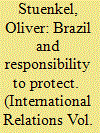

|
|
|
|
|
| Summary/Abstract |
This article questions the still broadly accepted notion that the global debate about Responsibility to Protect (R2P) is divided into a Western (or Northern) ‘pro-R2P’ camp and a non-Western (or Southern) ‘anti-R2P camp’. In the same way, the relatively broadly accepted assertion that R2P is a Western concept overlooks the important contributions developing countries have made in the creation of the norm. Brazil’s stance vis-à-vis R2P, analyzed in this article, is a powerful example of this reality, and the country has, in the past years, temporarily assumed leadership in the discussion about how to strengthen the norm. Paradoxically, Brazil’s move was widely seen as obstructionist. This points to a broader bias that tends observers not to grant non-Western powers the same agency in the creation of rules and norms. The ongoing multipolarization will force observers to correct this vision, as countries in the Global South such as China will be increasingly able to ‘act upon’ R2P, a capacity that so far has been reserved for established powers.
|
|
|
|
|
|
|
|
|
|
|
|
|
|
|
|
| 3 |
ID:
147702
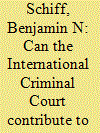

|
|
|
|
|
| Summary/Abstract |
The Responsibility to Protect (R2P) norm asserts that states have duties beyond their borders to help avoid, respond to, and prevent recurrence of circumstances that produce massive human rights violations. Actions undertaken to implement those duties can include aid, reform, or more muscular involvements. The need for such engagement implies that the target state’s government is losing or has lost its legitimacy. Labeling by the International Criminal Court (ICC) of a conflict as a ‘situation’ under its purview asserts that large-scale crimes are likely taking place for which individuals should be held accountable. This should trigger R2P considerations. However, the fit between R2P and the ICC is uncomfortable. Although the ICC may appear a useful tool for R2P, forays into the politics of R2P by the ICC are undertaken at its peril. Moreover, so far, the ICC has not clearly had positive effects upon conflict. While the ICC can be idealized as a contributor to R2P, coordination is formally non-existent and the Court’s protection effects are ambiguous.
|
|
|
|
|
|
|
|
|
|
|
|
|
|
|
|
| 4 |
ID:
147700
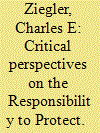

|
|
|
|
|
| Summary/Abstract |
The articles in this Special Issue derive from a conference on the Responsibility to Protect (R2P) held under the auspices of the Center for American and Global Security at Indiana University–Bloomington, 15–16 May 2015. The studies in this issue variously explore the development of the R2P in the United Nations, assess the role of the International Criminal Court in bringing perpetrators of mass atrocities to justice, introduce a territorial dimension to R2P, and elucidate the current position of non-Western emerging countries, specifically the BRICS, on R2P. The most ardent advocates of the doctrine tend to be from the major English-speaking liberal democracies, although prominent African statesmen were also instrumental in promoting the concept. The Libyan experience prompted a reassessment of R2P, magnifying suspicions that the norm may be simply a Western strategy for enhancing influence and effecting regime change. The idea of state sovereignty as responsibility domestically, and the possibility of international assistance to regimes struggling to protect vulnerable populations, has widespread support in the non-Western world. Coercive measures against predatory regimes are not rejected wholesale, but the BRICS are suspicious of Western motives in advocating forcible intervention and justifiably skeptical that such interventions will do more good than harm.
|
|
|
|
|
|
|
|
|
|
|
|
|
|
|
|
| 5 |
ID:
145732
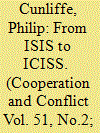

|
|
|
|
|
| Summary/Abstract |
In light of the post-intervention crisis in Libya, this article revisits critically the vision of the Responsibility to Protect (R2P) offered in the 2001 report of the International Commission on Intervention and State Sovereignty (ICISS) – frequently taken as the conceptual bedrock for R2P doctrine. It is argued that the perverse effect of ICISS doctrine is to replace political responsibility with paternalism. The demand that states be made accountable to the international community ends by making states accountable for their people rather than to their people. The argument is developed across five critical theses. These include claims that R2P changes the burden of justification for intervention, that it usurps popular sovereignty in favour of state power, and that it diffuses post-conflict responsibilities. The article concludes that pre-emptive ‘human protection’ efforts risk crowding out questions of systemic transformation, i.e. what kind of an international order we want to live in.
|
|
|
|
|
|
|
|
|
|
|
|
|
|
|
|
| 6 |
ID:
147704
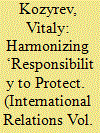

|
|
|
|
|
| Summary/Abstract |
This article examines the recent evolution of China’s policies toward the Responsibility to Protect (R2P) concept in the context of a changing international environment. As an example of an emerging ‘non-Western’ alternative to the existing normative consensus, the Chinese perception of the norm reflects the nature of the ongoing new East–West divide and is derived from Beijing’s new vision of a future world order and China’s role in it. In 2001–2011, China supported R2P as a new mechanism to revise Western practices of humanitarian interventionism and to contribute to a changing multilateral global international legal order exemplifying China’s new status as a responsible ‘global citizen’. When the R2P norm was politicized by the West as part of its global democratic interventionist policies of 2005–2014, China’s predominantly globalist vision of the international rule of law was replaced by its predominantly security-driven approach. This perspective, while recognizing the ongoing globalization of sovereignty, calls for a ‘right balance between justice and interest’ by the international community and denies the traditional Western leadership in the norm-making process. The Communist Party of China (CPC) leaders believe that the future evolution of the R2P concept should meet China’s strategic interests, including its global order-forming and institution-building initiatives. Efforts to operationalize the R2P norm will have to take this factor into account.
|
|
|
|
|
|
|
|
|
|
|
|
|
|
|
|
| 7 |
ID:
147706
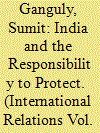

|
|
|
|
|
| Summary/Abstract |
India, though a working democracy, has adopted an ambivalent stance toward the genesis and evolution of the doctrine of the Responsibility to Protect. This article traces India’s views toward the earlier principle of humanitarian intervention, outlines its reactions toward the advent of the norm, and discusses India’s positions on the attempts to apply it to recent international crises. It then argues that India’s cautious support for the principle stems in part from concerns about its potential abuse in the hands of the great powers, post-colonial concerns about the diminution of the norm of state sovereignty, and finally, its own domestic vulnerabilities in the protection of human rights.
|
|
|
|
|
|
|
|
|
|
|
|
|
|
|
|
| 8 |
ID:
123892
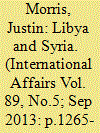

|
|
|
|
|
| Publication |
2013.
|
| Summary/Abstract |
This article examines recent UN Security Council deliberations over events in Libya and Syria and in particular assesses the extent to which Council members sought to justify their positions and voting behaviour by reference to the 'Responsibility to Protect' (R2P).
It shows how limited invocations of R2P were with regard to Libya, before proceeding to demonstrate how, somewhat paradoxically, R2P-sceptics such as Russia and China subsequently drew upon concerns over the manner in which NATO implemented its UN-mandate in Libya to cast doubts over R2P during debates over Syria.
Contemplating the implications of the Libyan and Syrian cases for the future of R2P, the article concludes by arguing that the concept's international standing can best be preserved through the excision of its most coercive elements; R2P should be reconstituted as a standard of acceptable sovereign behaviour and a mechanism geared towards the provision of international guidance and support, while decisions over coercive military intervention, inevitably infused with considerations of strategic interest, should be made outside the R2P framework.
|
|
|
|
|
|
|
|
|
|
|
|
|
|
|
|
| 9 |
ID:
097716
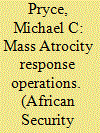

|
|
|
|
|
| Publication |
2009.
|
| Summary/Abstract |
The Mass Atrocity Response Operations (MARO) Project, a collaboration of Harvard University and the United States Army, focuses traditional military planning on the mission of genocide prevention. This article describes a generic planning framework designed for use by governments, regional peacekeeping organizations and NGOs to coordinate prevention and intervention efforts. This overview of the complex military planning process gives the civilian planner insight and introduces the anti-genocide community to a practical tool for turning rhetoric into considered action.
|
|
|
|
|
|
|
|
|
|
|
|
|
|
|
|
| 10 |
ID:
144707
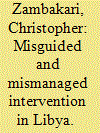

|
|
|
|
|
| Summary/Abstract |
In this paper, I critically analyse the doctrine of the Responsibility to Protect (RtoP), as it relates to the responsibility of intervening forces towards the people they claim to protect and the challenges that the situation in Libya now poses in the region and for the African Union (AU). I focus most of my attention on the coercive elements of the RtoP framework (Pillar III). This is the most contested element in the framework. Three questions guide this article: were there legitimate grounds to justify an external intervention in Libya? In the words of Hugh Roberts in Who Said Gaddafi Had to Go, ‘[w]hat if anything has Libya got in exchange for all the death and destruction that have been visited on it’ since 2011? What are the practical implications and consequences of the North Atlantic Treaty Organization (NATO) intervention, led by the United States (US), for regional peace? I discuss the problems surrounding the US–NATO intervention, followed by an analysis of the various positions and narratives leading up to the intervention, the framing and justifications provided for the intervention, and an analysis of the AU's proposal for the resolution of the Libyan crisis. I analyse the various debates that took place in the US (Pentagon/White House), at the United Nations, among scholars in the West and in Africa, and among various actors who tried to broker a ceasefire in Libya before and during the intervention. I conclude with a discussion of the implications for regional peace.
|
|
|
|
|
|
|
|
|
|
|
|
|
|
|
|
| 11 |
ID:
122087
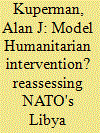

|
|
|
|
|
| Publication |
2013.
|
| Summary/Abstract |
NATO's 2011 humanitarian military intervention in Libya has been hailed as a model for implementing the emerging norm of the responsibility to protect (R2P), on grounds that it prevented an impending bloodbath in Benghazi and facilitated the ouster of Libya's oppressive ruler, Muammar al-Qaddafi, who had targeted peaceful civilian protesters. Before the international community embraces such conclusions, however, a more rigorous assessment of the net humanitarian impact of NATO intervention in Libya is warranted. The conventional narrative is flawed in its portrayal of both the nature of the violence in Libya prior to the intervention and NATO's eventual objective of regime change. An examination of the course of violence in Libya before and after NATO's action shows that the intervention backfired. The intervention extended the war's duration about sixfold; increased its death toll approximately seven to ten times; and exacerbated human rights abuses, humanitarian suffering, Islamic radicalism, and weapons proliferation in Libya and its neighbors. If it is a "model intervention," as senior NATO officials claim, it is a model of failure. Implementation of R2P must be reformed to address these unintended negative consequences and the dynamics underlying them. Only then will R2P be able to achieve its noble objectives.
|
|
|
|
|
|
|
|
|
|
|
|
|
|
|
|
| 12 |
ID:
115604
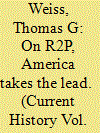

|
|
|
| 13 |
ID:
189873
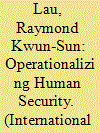

|
|
|
|
|
| Summary/Abstract |
The concept of human security, whose origin could be traced back to the 1994 Human Development Report published by the United Nations Development Programme (UNDP) represents an ambitious attempt to broaden the meaning of security and, perhaps most importantly, challenge the state-centric notion of national security. A resolution (A/RES/66/290) adopted by the United Nations (UN) General Assembly in September 2012 has, for the first time in UN history, formally recognized human security as an approach to ‘assist Member States in identifying and addressing widespread and cross-cutting challenges to the survival, livelihood and dignity of their people’. While the discussion of the human security concept continued within the UN, the advocacy of key UN member states for human security had been shifted to the Responsibility to Protect (R2P). Considering the fact that the potential role of the R2P to promote and operationalize human security has not been adequately explored, this article seeks to understand the positive potential role that R2P can play in operationalizing human security by exploring the relationship between the two. Acknowledging the efforts of Lloyd Axworthy, the former Canadian foreign minister, in situating ‘human security in the R2P era’, this article argues that R2P plays an important role in clarifying the scope and sharpening the focus of human security. This, therefore, can help strengthen the implementation of the human security concept.
|
|
|
|
|
|
|
|
|
|
|
|
|
|
|
|
| 14 |
ID:
122088
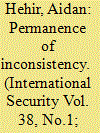

|
|
|
|
|
| Publication |
2013.
|
| Summary/Abstract |
Many observers heralded the Security Council-sanctioned intervention in Libya in March 2011 as evidence of the efficacy of the responsibility to protect (R2P). Although there is no doubt that the intervention was significant, the implications of Resolution 1973 are not as profound as some have claimed. The intervention certainly coheres with the spirit of R2P, but it is possible to situate it in the context of a trajectory of Security Council responses to large-scale intrastate crises that predate the emergence of R2P. This trajectory is a function of the decisionmaking of the five permanent members of the Security Council (P5), a group guided by politics and pragmatism rather than principles. As a consequence, the Security Council's record in dealing with intrastate crises is characterized by a preponderance of inertia punctuated by aberrant flashes of resolve and timely action impelled by the occasional coincidence of interests and humanitarian need, rather than an adherence to either law or norms. The underlying factors that contributed to this record of inconsistency-primarily the P5's veto power-remain post-Libya, and thus the international response to intrastate crises likely will continue to be inconsistent.
|
|
|
|
|
|
|
|
|
|
|
|
|
|
|
|
| 15 |
ID:
130267
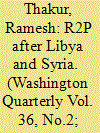

|
|
|
|
|
| Publication |
2013.
|
| Summary/Abstract |
The use of force-no matter how benevolent, enlightened, or impartial in intent-has dramatic consequences. It shapes the struggle for power and helps to determine the outcome of political contests, which is why it is inherently controversial. It is why international debates about Libya-the first road test of the Responsibility to Protect's (R2P) coercive element (also known as Pillar Three)-were understandably contentious. Pillar Three is defined as "the responsibility of Member States to respond collectively in a timely and decisive manner when a State is manifestly failing to provide?…?protection."1 While peaceful means of response are primarily preferred, should that prove inadequate to ensure protection, the international community should use more robust action: "no strategy for fulfilling the responsibility to protect would be complete without the possibility of collective enforcement measures, including through sanctions or coercive military action in extreme cases.
|
|
|
|
|
|
|
|
|
|
|
|
|
|
|
|
| 16 |
ID:
132056
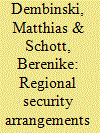

|
|
|
|
|
| Publication |
2014.
|
| Summary/Abstract |
Regional security arrangements play a central role in modifying emerging norms as they travel from the global to the local level. This process of norm localization is shaped by various factors such as the characteristics of regional security cultures, corresponding resonance with the emerging norm, institutional voice opportunities, and mechanisms of framing and pruning as they are utilized by norm entrepreneurs. The article applies this analytical framework to the localization of the responsibility to protect (R2P) norm by the African Union and the European Union. Subsequently, the paper examines how localization of the R2P norm in both regions affected their reactions to the Libyan crisis in 2011. It also examines the likely ramifications that the intervention may have on the future reception of the R2P by African and European actors.
|
|
|
|
|
|
|
|
|
|
|
|
|
|
|
|
| 17 |
ID:
119246
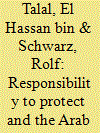

|
|
|
|
|
| Publication |
2013.
|
| Summary/Abstract |
Over the last 15 years, human rights concerns and development issues have been increasingly integrated with security matters on the international agenda. There is a growing understanding that justice, growth in welfare, and sustainable peace are goals that are deeply entwined. This new understanding of development - as encompassing human rights and security concerns to an equal extent - is reflected in the notion of the responsibility to protect. The responsibility to protect (R2P) represents a holistic approach to the challenges of international security, and one that enables human rights violations to be conceived of as a security issue. The arms embargo and humanitarian intervention in Libya and subsequent debate over intervention in Syria brought the issues of R2P into the heart of the Arab world. The Arab world has long been immune to these debates, but the historic changes in Tunisia and Egypt and the humanitarian intervention in Libya have shifted the debate and brought about a paradigm shift.
|
|
|
|
|
|
|
|
|
|
|
|
|
|
|
|
| 18 |
ID:
093775
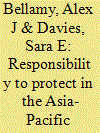

|
|
|
|
|
| Publication |
2009.
|
| Summary/Abstract |
In 2005, governments around the world unanimously agreed to the principle of the responsibility to protect (R2P), which holds that all states have a responsibility to protect their populations from genocide and mass atrocities, that the international community should assist them to fulfil this duty, and that the international community should take timely and decisive measures to protect populations from such crimes when their host state fails to do so. Progressing R2P from words to deeds requires international consensus about the principle's meaning and scope. To achieve a global consensus on this, we need to better understand the position of governments around the world, including in the Asia-Pacific region, which has long been associated with an enduring commitment to a traditional concept of sovereignty. The present article contributes to such an endeavour through its three sections. The first part charts the nature of the international consensus on R2P and examines the UN secretary-general's approach. The second looks in detail at the positions of the Asia-Pacific region's governments on the R2P principle. The final part explores the way forward for progressing the R2P principle in the Asia-Pacific region.
|
|
|
|
|
|
|
|
|
|
|
|
|
|
|
|
| 19 |
ID:
156249
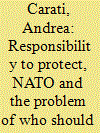

|
|
|
|
|
| Summary/Abstract |
One of the most challenging issues concerning the doctrine of the Responsibility to Protect (R2P) is ‘who should intervene’ in case of gross violations of human rights. After the intervention in Kosovo in 1999, the North Atlantic Treaty Organization (NATO) has been increasingly considered a legitimate actor to fulfil the duty to intervene for humanitarian reasons. In 2011, the first military intervention inspired by the R2P in Libya reinforced the appreciation of NATO as a viable enforcer of the doctrine. The paper problematizes the idea that NATO could be a straightforward solution to the problem of who should intervene. NATO's constitutive nature comprises aspects that are at odds with R2P as a normative scheme. In this regard, the paper delves into three aspects: (a) the controversial issue of ‘delegated authority’ from the UN to NATO; (b) the tension between the universalistic character of the R2P and the particularistic nature of NATO and (c) the military nature of the alliance and its consequent focus on security/military considerations that rarely, or just occasionally, match with humanitarian concerns. Finally, the paper analyses the intervention in Libya assessing the incongruities between NATO's military operations and the normative framework of R2P.
|
|
|
|
|
|
|
|
|
|
|
|
|
|
|
|
| 20 |
ID:
147708
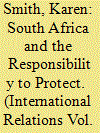

|
|
|
|
|
| Summary/Abstract |
This article provides an overview of the South African government’s evolving position on the Responsibility to Protect (R2P). While the country was an advocate of R2P in the run-up to the 2005 United Nations (UN) World Summit and the related idea of non-indifference in Africa, its conduct while serving as a non-permanent member of the United Nations Security Council (UNSC) and subsequent developments have raised questions about its continued commitment to these principles. In particular, Resolution 1973 (2011) on Libya proved to be a turning point. It is argued that while South Africa continues to support the broad idea of civilian protection, it is in favour of a consultative, regional approach and has become increasingly critical of what it views as the selective application and militarisation of the R2P. In trying to make sense of the apparent contradictions in South Africa’s position, it is necessary to situate the debate against the background of broader tensions in its foreign policy, particularly around the promotion of human rights. These, in turn, are linked to divergent and multiple foreign policy identities that the post-apartheid state is still coming to terms with.
|
|
|
|
|
|
|
|
|
|
|
|
|
|
|
|
|
|
|
|
|